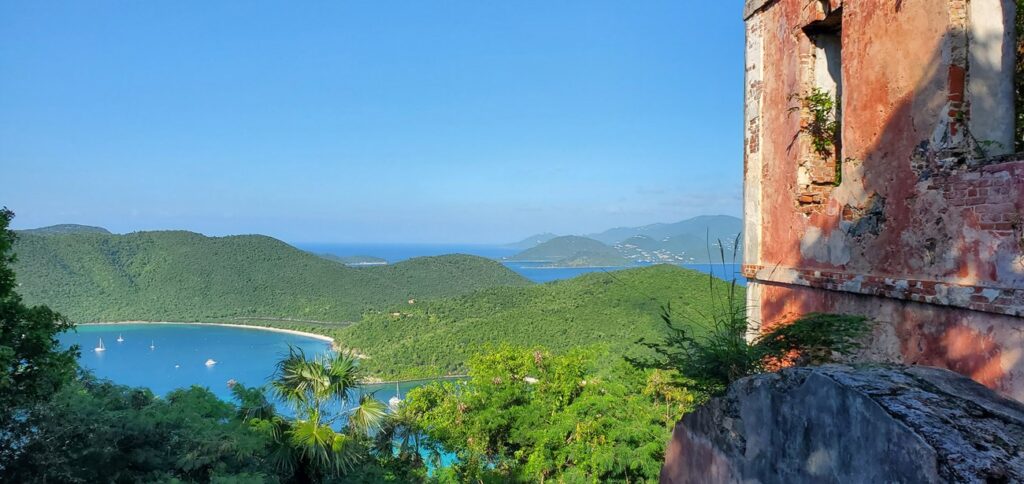Marketplace Suites Blog
Best USVI Island for Adventure Travelers

If you’re chasing an active, outdoors-first trip in the U.S. Virgin Islands, each island contains a unique flavor. St. Thomas is the easiest launchpad: the main airport, a busy charter scene, and quick-hit thrills; think ridge viewpoints, lively bays, and fast access to parasailing, sailing, and day trips. It’s high-energy and convenient, but you’ll share the marquee spots with cruise-day crowds. St. Croix spreads out the action: longer drives, fewer people, and standout experiences like Buck Island’s underwater trail, shore diving, and historic towns that reward slow exploration. It’s terrific if you want room to roam, but logistics can eat daylight. Water Island is a mellow micro-escape with a pretty beach and bikeable roads, great for a low-key day but too small to carry a full adventure itinerary. Then there’s St. John. Though the smallest, it packs disproportionate payoff: over 60% protected by Virgin Islands National Park, trailheads dropping to white-sand coves, mangrove mazes you can paddle at golden hour, and snorkel circuits that start right off the sand. In other words, less commuting, more doing. If your perfect day includes a hike, a reef, and a sunset paddle without touching a highway, you’ll find the best “adventure-per-hour” on St. John.
What makes St. John uniquely adventurous?
The core ingredients: protected landscapes, variety, and proximity. On St. John, one day can include a ridge hike through dry forest, a swim over a coral garden with sea turtles, and a sunset paddle in mangroves, without hours of driving. Trailheads, beaches, and launches stack close together, especially on the north and east shores. Outfitters are used to early risers. And the island’s vibe leans casual, eco-minded, and outdoorsy: fewer high-rises, more trail signs and park maps.
Bonus points that matter:
- Less crowded than St. Thomas; fewer cruise-day surges.
- Less developed than St. Croix; much of the coastline feels wild.
- Eco-tourism focused by design, thanks to national park stewardship.
How does the National Park shape your experience?
Virgin Islands National Park is the reason St. John still feels like St. John. Trails are maintained, signage is solid, cultural sites are preserved, and reefs benefit from rules that keep them healthy. The result: reliable access to world-class beaches, well-marked routes to hilltop ruins and petroglyphs, and designated moorings that protect coral. For travelers, that means you can plan bigger, go farther, and trust the infrastructure that underpins the island’s wildness.
Which hikes belong on your shortlist?

If you only have time for one signature trail, make it Reef Bay Trail. It’s a moderately challenging 4.4-mile trek (out-and-back or shuttle-supported) dropping from the upland forest through cathedral-like stands of tropical trees to a remote beach on the south shore. Along the way you’ll pass ancient petroglyphs carved near a freshwater pool, plus remnants of sugar-era ruins that tell a deeper story of the island. The National Park Service often runs a guided hike that includes rich natural/cultural interpretation and a scenic boat ride back to town, a smart move if you’d rather not climb back uphill in the afternoon heat.
Have extra time? Add these legs to your quiver:
- Ram Head: A dramatic, breezy headland hike with sweeping views and a memorable sunset return.
- Cinnamon Bay Nature Loop: Short, interpretive, and perfect for a leg-stretcher before or after beach time.
- Lind Point Trail: Hike straight from Cruz Bay to Salomon or Honeymoon Beaches, then swim and hike back, classic St. John combo.
- Brown Bay: Quieter backcountry feel, a good bet for solitude and birdlife.
Trail tips: Start early, carry more water than you think you need, and wear proper footwear (coral rubble and roots make flip-flops a bad idea). Always step on rock and sand, not on vegetation or live coral.
Where’s the best snorkeling on St. John?
Waterlemon Cay is the headline act, and deservedly so. A short shoreline walk from the parking area brings you to an easy entry point, and a swim around the cay rewards you with sea turtles, rays, and vibrant coral. Navigate clockwise to ride the typical current, scan the sand for conch and southern stingrays, and keep your distance from any turtle you spot (admire, don’t chase).
Round out your snorkel week with:
- Maho Bay: Turtle central in calm conditions; seagrass beds draw green turtles and rays.
- Hawksnest & Trunk: Iconic north shore clarity with patch reefs accessible from the beach.
- Salt Pond & Haulover: More advanced when swell is low; check conditions and ask locals before committing.
Snorkel ethics: Use reef-safe sunscreen, avoid standing on coral, and keep fins high above the reef to prevent accidental kicks.
What makes kayaking Hurricane Hole special?
Hurricane Hole is where the island exhales, calm waters, cathedral mangroves, dappled light, and the mesmerizing nursery life that mangroves protect. It’s a dream for kayakers and stand-up paddleboarders (SUPers) who want more than open-water paddling. You’ll thread through mangrove tunnels where juvenile fish, rays, and even baby sharks find shelter, and you can politely drift alongside the prop roots that host colorful sponges and tunicates. Go with a guide for the best natural history insights and to ensure you stay within the most resilient zones.
Paddling pointers: Plan for slack tide or gentle currents, keep voices down to hear the life around you, and avoid touching mangrove roots. Bring polarized sunglasses, they turn the water into a window.
Can you really camp on St. John?
Yes, and that’s a huge part of the island’s adventure DNA. Cinnamon Bay Campground gives travelers the option to sleep steps from the sea, wake with the birds, and roll straight into a day of hiking, snorkeling, or paddling. Whether you choose a tent platform, eco-tent, or cabin (based on current offerings), camping connects you to the island’s rhythms in a way no hotel corridor can. Pack light, bring a headlamp, and savor sunrise before the beach fills.
Prefer a soft bed and climate control but still want that first-to-the-trail feel? Base at Marketplace Suites in town for painless pre-dawn starts and easy re-provisioning after long days outside.
What about scuba, should you chase the RMS Rhone?

If you’re a certified diver, absolutely. The RMS Rhone, a storied 19th-century mail steamer, rests in nearby BVI waters, but St. John outfitters regularly run trips when conditions and border rules allow. The site is famous for photogenic swim-throughs, abundant marine life, and a tangible sense of history. Closer to home, charter operators also hit reefs and pinnacles off St. John and St. Thomas; visibility and life are typically excellent in calm seasons.
Dive notes: Verify passport and customs requirements for BVI day trips, and book early during peak months. For newer divers, start with a refresher shore dive before hopping on the boat.
How does St. John compare to St. Thomas and St. Croix for adventure?
All three islands offer beauty and outdoor options, but they feel different in motion:
- St. John: Less crowded, less developed, and more park-forward. Trail-to-beach link-ups are as good as it gets.
- St. Thomas: More built up, bigger harbor scene, great day-trip hub; you’ll need to choose your moments to avoid crowds.
- St. Croix: Larger and more spread out; historic towns and excellent diving, but longer drives between marquee spots.
If you prioritize high trail density, accessible reefs, and a conservation-first ethos, St. John is the clear winner.
When should adventure travelers go?
You can build a great trip nearly year-round; just match your plan to the season:
- Winter (Dec–Mar): Dry, comfortable temps; busiest months, book early. North swells can affect some beaches; protected bays still shine.
- Spring (Apr–Jun): Sweet spot for snorkeling clarity and calmer seas; fewer crowds.
- Summer (Jul–Aug): Warmer water, lush hillsides, and long days; start hikes early and hydrate.
- Fall (Sep–Oct): Quietest stretch; watch weather forecasts and be flexible with plans.
No matter when you go, aim for early starts, midday siestas, and golden-hour paddles to beat heat and maximize light.
How do you build a smart adventure itinerary?
Keep it modular: anchor each day with one big objective, then add optional, low-lift bonuses. Here are two sample frameworks.
3-Day “Hit the Highlights” Plan
- Day 1: Morning Reef Bay Trail (NPS-guided if available) → boat ride back → late lunch in Cruz Bay → sunset swim at Hawksnest.
- Day 2: Early snorkel circuits at Waterlemon Cay → picnic at Trunk Bay → twilight paddle in the Cruz Bay area with an outfitter.
- Day 3: Mangrove kayak at Hurricane Hole → afternoon lounge at Cinnamon Bay → stargazing from a quiet north shore turnout.
5-Day “Deeper Dive” Plan
- Day 1: Lind Point hike to Salomon/Honeymoon → snorkel → dinner in town.
- Day 2: Reef Bay Trail + petroglyphs → boat return → recovery swim at Maho Bay.
- Day 3: Scuba day (RMS Rhone if running) or a two-tank local charter → sunset at Ram Head (start late afternoon; bring headlamps).
- Day 4: Hurricane Hole paddle → explore East End pullouts → quiet dinner and early night.
- Day 5: Free-choice morning (trail repeat, SUP session, or beach hop) → long lunch → pack and wander Cruz Bay’s shops.
Build in rest windows. Adventure isn’t just output; it’s recovery, too. The best days end with a bit of good mood to spare.
What do you need to know about logistics?

- Arrivals: Fly into STT (St. Thomas), ferry to Cruz Bay (St. John). Ferries run frequently; check times as you plan.
- Transport: Many travelers rent a Jeep for trail and beach access; others rely on taxis and guided tours. Parking at marquee beaches can fill, early is your friend.
- Outfitters: Book kayaks, SUPs, snorkel gear, and dive trips ahead in peak months. Ask about delivery to Cruz Bay or beach meet-ups.
- Provisions: Stock up in town; keep a cooler ready for beach days. Hydration and snacks make or break a big morning.
- Connectivity: Cell phone signal can be spotty in backcountry pockets; download maps and ferry schedules offline.
Marketplace Suites advantage: Base yourself in the heart of St. John so pre-dawn starts, midday resets, and evening dinners are frictionless. You’re steps (or a short ride) from ferries, guides, groceries, and the island’s dining scene, which means more time outside and less time shuttling.
How do you travel responsibly on St. John?
St. John’s magic survives because travelers do their part:
- Use reef-safe sunscreen (non-nano zinc or titanium); better yet, wear sun shirts.
- Don’t touch coral or wildlife; observe turtles and rays from a respectful distance.
- Pack it in, pack it out, even micro-trash like fruit stickers and zip ties.
- Stick to marked trails to protect sensitive plants and prevent erosion.
- Float, don’t stand while snorkeling; keep fins off the reef and seagrass.
- Respect cultural sites and leave artifacts in place.
Adventure and stewardship aren’t opposites, they’re partners. The island rewards those who care for it.
Why pair St. John’s wild side with Marketplace Suites?
Because a great base camp multiplies what you can do. From Marketplace Suites, you can greet sunrise at a north shore overlook, rinse off by midday, and be back out for a mangrove paddle before dusk, without burning hours on logistics. You’ll have a comfortable reset between missions, easy access to dining when calories count, and a central launchpad that keeps your gear and plans organized. For travelers who measure success in first tracks on the trail and last light in the water, the right address matters.
So, which USVI island is best for adventure travelers?

Winner: St. John, hands down. It’s smaller, but it’s bigger where it counts: miles of national-park trails, beaches that look like postcards but feel like sanctuaries, and waters alive with reefs, turtles, and rays. Add low-key crowds, an eco-forward ethos, and logistics that let you stack hikes, paddles, and snorkels into the same day, and the choice gets easy. Whether you’re tackling the Reef Bay Trail, circling Waterlemon Cay, weaving through Hurricane Hole, camping at Cinnamon Bay, or booking that bucket-list RMS Rhone dive, St. John serves up the most adventure per hour spent.
Ready to turn intention into itinerary?
Trade scrolling for doing. Book your stay on St. John at Marketplace Suites, plant yourself in the heart of the action, and let each day start with a trail, a tide, or a paddle. Your gear will dry, your legs will hum, and your camera roll will finally look like the trip you meant to take. The island is ready when you are, reserve your base camp at Marketplace Suites today and make St. John your launchpad for the best adventures in the USVI.







